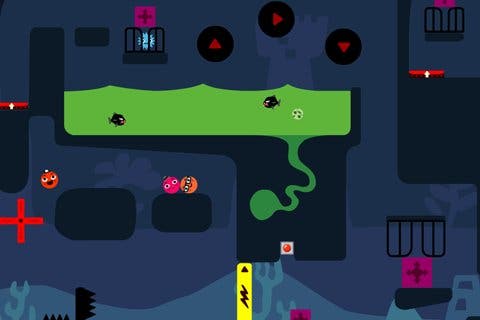Rolando
Starring roll.
There's also the sleeping, double-size king, who takes at least two rolandos to push over minor inclines and divots, and another one to halt him. The number of rolandos involved - or rather, that you need to involve - for individual tasks varies, but any left behind hold their ground and can be brought in to assist, or transported to the goal separately, by tapping their icon in the corner of the screen to re-centre the camera, and then selecting them and moving out. The number available rarely reaches half-a-dozen.
Yet levels quickly become more elaborate in other ways. There are bombs, which you dispense from a chute by tapping a red button above it, and these are used to blow away cracked-rock obstructions, but often only after you've positioned a rolando to bounce them out of the dispenser in the desired direction, or, more perilously, by pushing them directly and then getting out of the way. There are doors controlled by pressure switches, and pulleys, and numerous gizmos that you operate with your finger - bridges that you draw out of thin air from fixed points, catapults, conveyor belts, springboards, platforms, fans, and cross-shapes and flaps to rotate and draw back to let rolandos past.
Most, if not all of these elements have been seen before, but it's the manner of their composition that singles Rolando out. The combination of multiple rolandos, which only come to life once selected, and familiar platform puzzle architecture are superbly complemented by sympathetic, self-conscious construction. HandCircus also strips things back now and then to change the pace. Bonus levels give you 360-degree rotational control to drop a tumbling king solo through mazes, reminiscent of Cameltry, while other levels set the prince free and rely on your input to shift blockades in time with his movement.

Sadly though, having built up a strong foundation of slow and meticulous going, later levels become too condensed and fiddly, and jumping can be thrown off when the game reads an upward flick as an attempt to control a nearby platform or spring, while platform sequences necessitate too much repetition; manoeuvring rolandos through networks of tunnels one by one to avoid hazards. There also isn't that much incentive to revisit the game on completion, with rather drab time-attack and gem-collection sub-objectives. Having paid so much attention to how LocoRoco looks, HandCircus might also have spent time considering the reward system and spin-off mini-games that made the second PSP release stand out.
For the most part, though, Rolando demonstrates a powerful command of the iPhone's strengths and weaknesses. Apple was always confident that iPhone games would reach a level of quality comparable to the best of DS and PSP, despite the absence of an established first-party studio to set the pace, and this is the strongest evidence yet that Steve Jobs and friends were right. Rolando is derivative, but no less essential for this, and the attention to technical detail is often exemplary.
Rolando is available now from the iTunes App Store for GBP 5.99.

